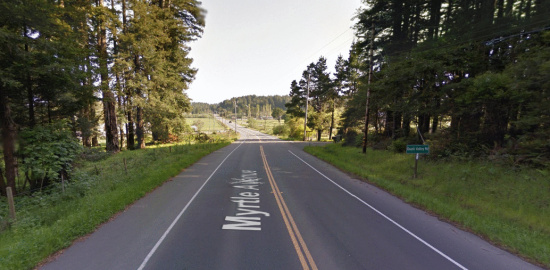Jason Anthony Warren’s defense attorney, Glenn Brown with the county’s Alternate Counsel office, made no opening statement, called only two witnesses to the stand and took less than three hours to mount a rather feeble defense of his client, who stands charged with two counts of murder, one with special allegations of torture and lying in wait, and two counts of attempted murder.
Resuming the case after a weeklong Thanksgiving break, Special Prosecutor Paul Sequeira read a statement about the 2001 crimes that foreshadowed the events of the current case. In that year Warren admitted in Humboldt County Superior Court that he had “willfully, unlawfully and with malice aforethought attempted to murder Cid Miller,” a taxi cab driver, on April 10, 2001, the statement said. Warren also admitted assaulting Arcata resident Fred Her with a deadly weapon — namely, the taxi cab, which he’d stolen after stabbing Miller. Warren was just 16 years old at the time.
The statement represented the conclusion of the prosecution’s case.
And so, nearly four weeks after the trial began and more than three years since the crimes were committed, it was the defense attorney’s turn to argue his side. Brown opted not to give an opening statement. He’d chosen not to offer opening remarks at the beginning of the trial, either, though Judge Timothy Cissna said at the time that he’d have an opportunity at the beginning of the defense’s case. That opportunity came and went today.
Instead, Brown called to the stand a witness named Steven Walker, who described himself as a retired California Highway Patrolman now self employed as a “traffic collision reconstruction consultant” who’s usually hired by public defense attorneys.
In his testimony, Walker addressed the scene of the collision between a 2005 Kia Spectra, allegedly driven by Warren, and the three women and a dog struck from behind on Myrtle Avenue, north of Eureka, back in September 2012. Walker offered an alternative interpretation of the field of evidence from that presented earlier in the case by several collision reconstruction specialists. He suggested that the driver may have lost control of the vehicle after coming out of a downhill curve, swerved across the oncoming lane of traffic and onto the opposite shoulder, inadvertently hitting the three runners and dog before correcting course.
Brown had Walker review a diagram and photos of the accident scene, which Walker said indicated that the car followed a curved path. While the collision itself happened on a long straightaway, Walker suggested that the driver may have been thrown off course after cresting a hill and encountering a curve before that straightaway.
Walker faced skeptical, even incredulous cross-examination from Sequeira, who questioned Walker’s credentials along with his take on the evidence.
Walker had mentioned using Google Earth to review the approach to the collision scene, and Sequeira called up that technology on a large monitor in the courtroom. He showed an image of what the roadway looks like from the top of the hill in question:
Google Earth image.
“You don’t consider that a dangerous roadway by any stretch, do you?” Sequeira asked.
“No,” Walker conceded.
Sequeira then quoted — perhaps mockingly — from Walker’s own report on the accident scene. “‘In a visceral sense, a northbound driver would lose his visual space cushion,’” Sequeira read. What did that mean?
Walker attempted to describe a distinction between a driver’s visceral sense and analytical sense of the roadway.
Another line in his report mentioned that the road “curves remarkably.”
Sequeira gestured at the screen. “What’s remarkable about that curve?” he asked. “Doesn’t that look like a gentle turn?”
Walker described it as a 45-degree turn.
Sequeira continued picking away at Walker’s analysis, finally arriving at the collision itself. The Kia, Sequeira pointed out, hit all three women and the dog, striking one of the women dead-center on the bumper and windshield, despite the fact that they were within the shoulder on the opposite side of the road. Doesn’t that speak to intent? Sequeira asked.
Walker would not concede that it did.
The final witness in the case was Cheryl Magnusson-Franco, a Humboldt County Sheriff’s investigator who’d testified on Nov. 12. Brown played a segment of security camera footage captured at the Hoopa home of Dorothy Ulrich roughly 12 hours before she was stabbed and bludgeoned to death with a samurai sword. The footage showed Warren, Ulrich and a neighbor smoking and talking about a gun that had been stolen from Ulrich’s property recently.
Judge Cissna instructed the jury that the footage wasn’t being shown for the purpose of possibly impeaching the prior testimony of the neighbor, Tiffany Martin.
And with that, Brown rested his case.
Cissna told the jurors that court will reconvene Wednesday morning at 8:30, when the jury will be given instructions for deliberation and the attorneys will deliver their closing arguments.
PREVIOUSLY:
- Jury Hears Audio of Dorothy Ulrich’s Violent Death on First Day of Warren Trial
- Attorneys Spar Over Evidence Before Warren’s Health Forces Early Recess in Double-Murder Case
- Jury Sees Photos of Battered, Blood-Smeared Kia on Day Three of Warren Trial
- Warren Trial, Day Four: Security Footage, Samurai Swords and a Vanishing Witness
- Warren Trial, Day Five: ‘The Type of Scream You Hear in a Horror Movie’
- Warren Trial, Day Six: The Evidence Mounts
- Warren Trial, Day Seven: The Autopsies
- Warren Trial, Day Eight: The DNA Matches, But Warren’s Wife Stops Short of Positive ID
- Warren Trial, Day Nine: Murders Foreshadowed by Similar Crimes a Decade Earlier
- Warren Trial, Day 10: Doctor Details Brain Injuries of Hit-and-Run Victims

CLICK TO MANAGE